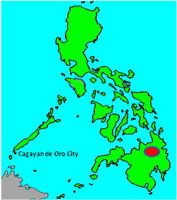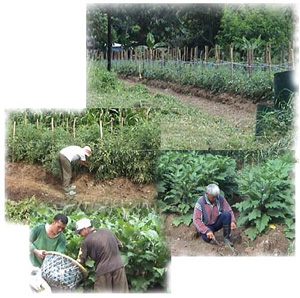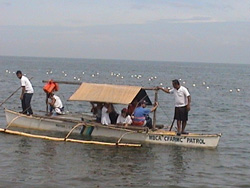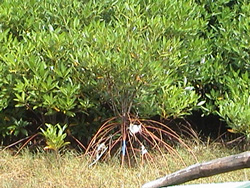Brief introduction of Cagayan de Oro City

Cagayan de Oro, the capital city of Misamis Oriental Province, is a sprawling industrializing City on the north-central coast of the island of Mindanao, serving as a major gateway to the Visayan islands to the north. The city is bounded on the north by the Macabalan Bay, on the south by the Provinces of Bukidnon and Lanao del Sur, on the east by the Municipality of Tagoloan, and on the west by the Municipality of Opol. Cagayan de Oro is the development hub of Region 10, with trading and service sectors contributing about 50% of total investment of the province.
Sustainable Cagayan de Oro Project (SCdOP)
The Sustainable Cities Programme was implemented in the Philippines through the "Strengthening Local Environmental Planning and Management" (L-EPM) by the Department of Environment and Natural Resources (DENR). The Project was established to strengthen the Local Government Units (LGUs) and enhance their capacities for participatory environmental planning and management at the local level, whilst enhancing the capability of national institutions like DENR and the League of Cities of the Philippines (LCP) to support LGUs in EPM. Through the financial support from the United Nations Development Programme (UNDP) and UN-HABITAT, the three year programme was implemented through a Project Management Coordinating Unit (PMCU) established in the DENR, in partnership with the LCP.
The Cagayan de Oro City was chosen as one of three demonstration cities of the Local-EPM Project, based on a selection process conducted by the Project Steering Committee (PSC), Inter-Agency Technical Working Group (IA-TWG) and the Project Management Coordinating Unit (PMCU). The project was launched in December 1998 after the Mayor signed the Memorandum of Agreement for the project implementation, committing to enhance the city government's capabilities by pioneering the integration of environmental planning and management within the city organizations As part of the Mayor's commitment for project implementation the city L-EPM unit was established under the City Environment and National Resources Office (City ENRO) from the start, which provided regular staff and an annual budget to help institutionalize project support from inception. Whilst the Local-EPM project ended in the first quarter of 2002, a Cooperation Agreement between UN-HABITAT and The Department of Interior and Local Government (DILG) was forged in January 2005, facilitating a second phase of support to document L-EPM experiences amongst the DILG partners, review opportunities to mainstream lessons learned in the Local Government Units (LGUs) and collaborate in the implementation of the Good Practices in Local Governance facility for Adaptation and Replication ("GOFAR").
Cagayan de Oro City Environmental Profile
The process of developing the City Environmental Profile (CEP) was instrumental to enhance and update the city's data base, which included information provided by different city stakeholders. The CEP became a fundamental tool to enhance stakeholder understanding and appreciation on interactions between development activities and natural resources, which highlighted the cross-cutting nature of environmental issues and the need for joint cros-sectoral efforts to improve the city's socio-economic development. Over the years the design of the CEP as a data base expanded as an important source of data when preparing Environmental Impact Assessments for major project proposals. Preparation of the CEP also helped identify the main environmental problems, such as solid waste management, coastal pollution, and the opportunities to use waste as compost for agricultural productivity, etc.
Cagayan de Oro City Consultation
The city consultation was held in December 1999, when representatives from local government, national line agencies, Barangay units, local universities, environmental related NGOs, `private sector and people's organizations attended the four day event. Six consultation groups were established to validate the draft City Environmental Profile, by discussing the probable causes of problems identified in the profile, and suggesting strategic solutions to solid waste management, coastal pollution and agricultural productivity. In order to catalyze further cross-sectoral coordination and public participation a number of environmental improvement projects were identified: strengthening solid waste management by composting biodegradable wastes, city coastal clean-up, artificial reef development, mangrove rehabilitation and plantation project, peri-urban organic farming, water resource management, and the development of a fish sanctuary.
At the time that the Local Environmental Planning and Management (L-EPM) process was introduced, the city already had an existing Comprehensive Land Use Plan (CLUP) therefore, rather than developing another document, the project integrated the City Environmental Profile developed from the EPM process with the Socioeconomic Profile of the CLUP, thus resulting to a Socio-ecological Profile of the City. This integration has effectively upgraded the database of the City, which is managed by the City Planning and Development Office. The EPM products like the priority issues, strategies and action plans were likewise picked up by both the City Planning and Development Office and City Local Environment and Natural Resources Office as basis for implementation.
Key Environmental Issues and Demonstration Projects
- Priority Issues
-
- Solid waste management (SWM)
- Coastal pollution
- Demonstration Projects
-
- - Recovery of municipal solid waste into compost
- Per-urban organic farming and water management development - - City coastal clean-up
- Artificial reef development
- Mangrove rehabilitation and plantation
- Fish sanctuary project
- - Recovery of municipal solid waste into compost
Brief Description of Demonstration Projects
Given the fact that solid waste management was the priority issue in Cagayan de Oro City and its 40 Barangays, part of the demonstration projects were developed to introduce innovative practices on SWM by strengthening Public Private Partnerships, sorting at source, bio-degradable composting & recycling, and developing peri-urban agriculture through community gardening. In the process of implementation especially regarding composting technologies, the sharing of experiences from the Sri Lankan SCP cities were instrumental in building awareness, and adapting appropriate composting technologies.
The three pilot Barangays selected as demonstration projects on SWM were Bugo, Lapasan and Gusa. The local government of Gusa was also identified for coastal management projects, which included a fish sanctuary, artificial coral reefs, and mangrove reforestation.
* The Integrated Solid Waste Management Project (ISWMP) and Allotment Garden in the Barangay Bugo
The Integrated Solid Waste Management Project of Bugo was pioneered by the Local Environmental Planning and Management (L-EPM) process, and is now promoted by DILG's "Good Practice in Local Governance: Facility for Adaptation and Replication" (GO-FAR). The focus of DILG's program is to support LGU efforts in confronting local environmental issues through city-to-city exchanges. KALAMBUAN or the ISWM project of Bugo was designed to answer the garbage issue in the Barangay. It emphasized waste segregation as an initial and important component in any proper garbage disposal system, creating livelihood opportunities for the marginalized fraction of the Barangay population. KALAMBUAN has earned Barangay Bugo an award from the Department of Environment and Natural Resources' "National Search for Model Barangay" for its Eco-Waste Management in 2004. Currently, there is a plan to expand the project throughout Bugo with a 5-year implementation plan. Prioritization will depend on the immensity of the waste problem of the Barangay, and an available area for an accessible community garden. (download full document)
Through the GO-FAR scheme, the City of Surigao has volunteered to the BLGD-DILG to replicate the experiences of Cagayan De Oro city. A Manual on Replication has been developed to guide the Local Government Units which are interested to undergo the GO FAR/EPM Process.

Peri-urban Agriculture under ISWM
* Coastal Management Projects in the Barangay Gusa
 Looking for sanctuary location
Looking for sanctuary locationWhilst Barangay Gusa has traditionally been one of Cagayan de Oro's main sources of fish catch, by the end of the 1990's it was experiencing a critical depletion of marine resources. Applying the SCP process, stakeholders identified costal zone management as their top priority and, after securing the cooperation of the fishing community, the stakeholder issue Working Group prioritised efforts to preserve marine resources and rehabilitate/reforest the marine ecosystem in order to increase the fish stock. The end result was establishment of a fish sanctuary in a 8.6 hectare area chosen because of its relatively undisturbed environment, considerable distance from households, and mild nature of its currents.
 The mangrove plantation
The mangrove plantationToday the sanctuary houses 43 units of concrete pyramid "corals", supported by nearby mangrove re-afforestation. Field visit orientations for city-folk continues to build awareness and support for wider replication, mobilising civil society support for regular beach clean-ups by reminding them of the endangered state of their marine life. Support for the project was obtained and sustained through regular Working Group meetings and planning sessions, information drives, and clean-up activities to root marine conservation in the collective consciousness of all citizens. The project coupled with enforced legislation against over exploitation of fish stocks by non-local fisher folks, which was reflected in the significant increases of fish stocks.
Results and Lessons Learned
The Manual on "Integrating Local Environmental Planning and Management (LEPM) in Comprehensive Land Use Planning" (CLUP) was a significant product from the experience of Cagayan de Oro, which integrated L-EPM into its comprehensive development planning process, and how as a result, a community has gained greater strength and impetus in pursuing sustainable development.
Introducing SCP-EPM boosted the city's local understanding of sustainable development, and in particular fostered an significant attitudinal change regarding local information management, by formally recognizing and making use of an integrated data base including GIS-EMIS.
The Cagayan de Oro L-EPM Project was able to leverage additional funds to mainstream solid waste management from the European Union, becoming a national model for replication.
Currently, the Cagayan De Oro City Local Environment and Natural Resources Office have seconded staff from various Departments and Divisions of the City government to ensure its continued integration within the LGU administrative framework, with steps to make it a regular unit of the City Government in the next year or so.
In coordination with the Liceo De Cagayan University, the Center of EPM studies for Mindanao (CEPMSM) was recently established to train prospective key local government officials on good governance as well as to serve as a venue for laying-out networks and building- up broader partnerships among institutions and LGUs. The center also constitutes the city's first information hub. Although still early to predict impacts, the CEPMSM may be taken as a good case of transforming EPM experience into need-driven postgraduate program such as EPM. City EPM practitioners in Southern Philippines have this institution as ground for integrating practice with teaching and research.
(http://www.dilg.gov.ph/blgd/lepm.htm)
Key Contacts and Associates
CLENRO, Cagayan De Oro City, Jocelyn Salcedo,
Liceo De Cagayan University, Rosalina Huerbana, srlsf@ldcu.edu.ph
DILG L-EPM website: http://www.dilg.gov.ph/blgd/lepm.htm
GO-FAR/L-EPM Brochure 1 (PDF 1.19MB)
GO-FAR/L-EPM Brochure 2 (PDF 1.03MB)
Full report of Cagayan de Oro City L-EPM Project (PDF 1.07MB)
Making Waste Big - Barangay Bugo, Cagayan de Oro City (PDF 1.55MB)
Arming the Waters - Barangay Gusa, Cagayan de Oro City (PDF 697KB)
Integrated Solid Waste Management Project (ISWMP) in Barangay Lapasan (PDF 743KB)
GO-FAR/L-EPM Replication Guideline (PDF 298KB)
League of Cities of the Philippines (LCP) document (PDF 764KB)




















